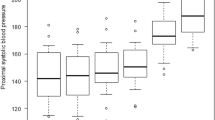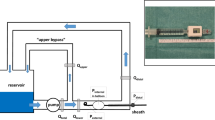Abstract
Introduction
Resuscitative endovascular balloon occlusion of the aorta (REBOA) increases proximal arterial pressure, but may also induce life-threatening distal ischemia. Partial REBOA (P-REBOA) is thought to mitigate distal ischemia during aortic occlusion. However, feasible indicators of the degree of P-REBOA remain inconsistent. We hypothesised percent balloon volume could be a substitute for pressure measurements of gradients during P- REBOA. This study aimed to compare balloon volume and arterial pressure gradient, and analysed with intra-balloon pressure and balloon shape.
Methods
Proximal (carotid) and distal (femoral) arterial pressures were recorded and a 7-Fr REBOA catheter was placed in four swine. Total REBOA was defined as a cessation of distal pulse pressure and maximum balloon volume was documented. The balloon volume was titrated by 20% increments of maximum capacity to adjust the degree of P-REBOA. The distal/proximal arterial pressure gradient and the intra-balloon pressures were also recorded. The changes in shape and the cross-sectional area of the balloon were evaluated with computed tomography (CT) images.
Results
The proximal mean arterial pressure (MAP) plateaued after 60% balloon volume; meanwhile, distal pulse pressure was still left. The balloon pressure was traced with proximal MAP before contact with aortic wall. The balloon shape changed unevenly from “cone” to “spindle” shape, although the balloon cross-sectional area of the mid-segment linearly increased.
Conclusion
Monitoring distal pressure and titrating percent balloon volume is feasible to manage P-REBOA. In this experiment, 60% balloon volume was enough inflation to elevate central pressure allowing distal perfusion. The intra-balloon pressure was not reliable due to the strong influence of proximal MAP and uneven change of the balloon shape.





Similar content being viewed by others
References
Sadeghi M, Nilsson KF, Larzon T, Pirouzram A, Toivola A, Skoog P, et al. The use of aortic balloon occlusion in traumatic shock: first report from the ABO trauma registry. Eur J Trauma Emerg Surg. 2018;44(4):491–501. https://doi.org/10.1007/s00068-017-0813-7.
Matsumura Y, Matsumoto J, Kondo H, Idoguchi K, Funabiki T, investigators D-I. Partial occlusion, conversion from thoracotomy, undelayed but shorter occlusion: resuscitative endovascular balloon occlusion of the aorta strategy in Japan. Eur J Emerg Med. 2018;25(5):348–54. https://doi.org/10.1097/MEJ.0000000000000466.
Brenner M, Inaba K, Aiolfi A, DuBose J, Fabian T, Bee T, et al. Resuscitative endovascular balloon occlusion of the aorta and resuscitative thoracotomy in select patients with hemorrhagic shock: early results from the american association for the surgery of Trauma's aortic occlusion in resuscitation for trauma and acute care surgery registry. J Am Coll Surg. 2018;226(5):730–40. https://doi.org/10.1016/j.jamcollsurg.2018.01.044.
Lendrum R, Perkins Z, Chana M, Marsden M, Davenport R, Grier G, et al. Pre-hospital resuscitative endovascular balloon occlusion of the aorta (REBOA) for exsanguinating pelvic haemorrhage. Resuscitation. 2019;135:6–13. https://doi.org/10.1016/j.resuscitation.2018.12.018.
Manzano-Nunez R, Orlas CP, Herrera-Escobar JP, Galvagno S, DuBose J, Melendez JJ, et al. A meta-analysis of the incidence of complications associated with groin access after the use of resuscitative endovascular balloon occlusion of the aorta in trauma patients. J Trauma Acute Care Surg. 2018;85(3):626–34. https://doi.org/10.1097/TA.0000000000001978.
Davidson AJ, Russo RM, Reva VA, Brenner ML, Moore LJ, Ball C, et al. The pitfalls of resuscitative endovascular balloon occlusion of the aorta: risk factors and mitigation strategies. J Trauma Acute Care Surg. 2018;84(1):192–202. https://doi.org/10.1097/TA.0000000000001711.
Taylor JR 3rd, Harvin JA, Martin C, Holcomb JB, Moore LJ. Vascular complications from resuscitative endovascular balloon occlusion of the aorta: life over limb? J Trauma Acute Care Surg. 2017;83(1 Suppl 1):S120–S123123. https://doi.org/10.1097/TA.0000000000001514.
Joseph B, Zeeshan M, Sakran JV, Hamidi M, Kulvatunyou N, Khan M, et al. Nationwide analysis of resuscitative endovascular balloon occlusion of the aorta in Civilian Trauma. JAMA Surg. 2019. https://doi.org/10.1001/jamasurg.2019.0096.
Matsumura Y, Matsumoto J, Kondo H, Idoguchi K, Ishida T, Kon Y, et al. Fewer REBOA complications with smaller devices and partial occlusion: evidence from a multicentre registry in Japan. Emerg Med J. 2017;34(12):793–9. https://doi.org/10.1136/emermed-2016-206383.
Reva VA, Matsumura Y, Horer T, Sveklov DA, Denisov AV, Telickiy SY, et al. Resuscitative endovascular balloon occlusion of the aorta: what is the optimum occlusion time in an ovine model of hemorrhagic shock? Eur J Trauma Emerg Surg. 2018;44(4):511–8. https://doi.org/10.1007/s00068-016-0732-z.
Russo RM, Williams TK, Grayson JK, Lamb CM, Cannon JW, Clement NF, et al. Extending the golden hour: Partial resuscitative endovascular balloon occlusion of the aorta in a highly lethal swine liver injury model. J Trauma Acute Care Surg. 2016;80(3):372–8. https://doi.org/10.1097/TA.0000000000000940(discussion 8–80).
Kuckelman J, Barron M, Moe D, Derickson M, Phillips C, Kononchik J, et al. Extending the golden hour for zone 1 reboa: improved survival and reperfusion injury with intermittent versus continuous reboa in a porcine severe truncal hemorrhage model. J Trauma Acute Care Surg. 2018. https://doi.org/10.1097/TA.0000000000001964.
Sadeghi M, Horer TM, Forsman D, Dogan EM, Jansson K, Kindler C, et al. Blood pressure targeting by partial REBOA is possible in severe hemorrhagic shock in pigs and produces less circulatory, metabolic and inflammatory sequelae than total REBOA. Injury. 2018;49(12):2132–41. https://doi.org/10.1016/j.injury.2018.09.052.
Madurska MJ, Jansen JO, Reva VA, Mirghani M, Morrison JJ. The compatibility of computed tomography scanning and partial REBOA: a large animal pilot study. J Trauma Acute Care Surg. 2017;83(3):557–61. https://doi.org/10.1097/TA.0000000000001574.
Reva VA, Matsumura Y, Samokhvalov IM, Pochtarnik AA, Zheleznyak IS, Mikhailovskaya EM, et al. Defining degree of aortic occlusion for partial-REBOA: a computed tomography study on large animals. Injury. 2018;49(6):1058–63. https://doi.org/10.1016/j.injury.2018.04.021.
Russo RM, Neff LP, Lamb CM, Cannon JW, Galante JM, Clement NF, et al. Partial resuscitative endovascular balloon occlusion of the aorta in swine model of hemorrhagic shock. J Am Coll Surg. 2016;223(2):359–68. https://doi.org/10.1016/j.jamcollsurg.2016.04.037.
Johnson MA, Neff LP, Williams TK, DuBose JJ, Group ES. Partial resuscitative balloon occlusion of the aorta (P-REBOA): Clinical technique and rationale. J Trauma Acute Care Surg. 2016;81(5 Suppl 2):S133–S137137. https://doi.org/10.1097/TA.0000000000001146.
Williams TK, Neff LP, Johnson MA, Ferencz SA, Davidson AJ, Russo RM, et al. Extending resuscitative endovascular balloon occlusion of the aorta: endovascular variable aortic control in a lethal model of hemorrhagic shock. J Trauma Acute Care Surg. 2016;81(2):294–301. https://doi.org/10.1097/TA.0000000000001075.
Brenner M, Hoehn M, Pasley J, Dubose J, Stein D, Scalea T. Basic endovascular skills for trauma course: bridging the gap between endovascular techniques and the acute care surgeon. J Trauma Acute Care Surg. 2014;77(2):286–91. https://doi.org/10.1097/TA.0000000000000310.
Biffl WL, Fox CJ, Moore EE. The role of REBOA in the control of exsanguinating torso hemorrhage. J Trauma Acute Care Surg. 2015;78(5):1054–8. https://doi.org/10.1097/TA.0000000000000609.
Rasmussen TE. Update on Resuscitative Endovascular Balloon Occlusion of the Aorta (REBOA) Remote Damage Control Resuscitation Symposium. 2016. https://rdcr.org/wp-content/uploads/2016/07/13-Rasmussen-20116-RDCR-Symposium-V2.pdf. Accessed 15 Nov 2019
Acknowledgements
We appreciate Tomomasa Ttateno RT(R), Sho Kawai RT(R), Fumiharu Jimbo RT(R), Ryo Owada RT(R) for taking and processing CT images. We thank all members of the Centre for Development of Advanced Medical Technology, Jichi Medical University.
Funding
Grant-in-Aid for Research Activity Start-up, Japan Society for the Promotion of Science (JSPS) KAKENHI Grant Number, 17H06567.
Author information
Authors and Affiliations
Contributions
YM, a corresponding author, was responsible for drafting, editing, and submission of the manuscript. YM, AH, SH, and YI conducted the animal experiment and collected the data. HK, VR, SO, and JM critically appraised the manuscript. All the authors read and approved the final manuscript.
Corresponding author
Ethics declarations
Conflict of interest
Yosuke Matsumura was a Clinical Advisory Board Member at Tokai Medical Products. Other authors declare no conflict of interest.
Ethical approval
This study was conducted in an accredited animal research laboratory (Centre for Development of Advanced Medical Technology, Jichi Medical University, Tochigi, Japan). Institutional Animal Experiment Committee approval was obtained before beginning the study (authorisation number 17045-01).
Electronic supplementary material
Below is the link to the electronic supplementary material.
Rights and permissions
About this article
Cite this article
Matsumura, Y., Higashi, A., Izawa, Y. et al. Distal pressure monitoring and titration with percent balloon volume: feasible management of partial resuscitative endovascular balloon occlusion of the aorta (P-REBOA). Eur J Trauma Emerg Surg 47, 1023–1029 (2021). https://doi.org/10.1007/s00068-019-01257-4
Received:
Accepted:
Published:
Issue Date:
DOI: https://doi.org/10.1007/s00068-019-01257-4




